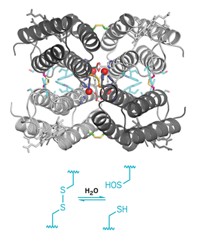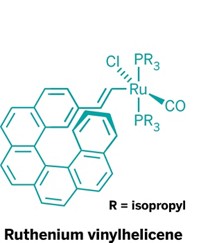Advertisement
Grab your lab coat. Let's get started
Welcome!
Welcome!
Create an account below to get 6 C&EN articles per month, receive newsletters and more - all free.
It seems this is your first time logging in online. Please enter the following information to continue.
As an ACS member you automatically get access to this site. All we need is few more details to create your reading experience.
Not you? Sign in with a different account.
Not you? Sign in with a different account.
ERROR 1
ERROR 1
ERROR 2
ERROR 2
ERROR 2
ERROR 2
ERROR 2
Password and Confirm password must match.
If you have an ACS member number, please enter it here so we can link this account to your membership. (optional)
ERROR 2
ACS values your privacy. By submitting your information, you are gaining access to C&EN and subscribing to our weekly newsletter. We use the information you provide to make your reading experience better, and we will never sell your data to third party members.
Synthesis
Switchable Catalysts
Materials Chemistry: Synthetic compounds mimic enzymes’ on-off property
by Mitch Jacoby
October 4, 2010
| A version of this story appeared in
Volume 88, Issue 40
Catalysts don’t usually come with an on-off switch. But catalytically active supramolecular complexes can be designed to controllably flip back and forth between configurations that selectively mediate or inhibit a reaction, according to researchers at Northwestern University (Science 2010, 330, 66). The study suggests new strategies for designing flexible catalysts that can be regulated by simple chemical means.
In response to specific chemical stimuli, such as the presence of certain ions, allosteric enzymes undergo conformational changes that can regulate enzyme activity. These conformational changes are typically triggered by binding of the ion or other chemical stimuli to a site other than the enzyme’s active site.
If the same type of response could be elicited from metal-containing organic molecules, then allosterism could serve as a new type of handle with which to control the variety of reactions catalyzed by that broad class of compounds. But engineering molecules that mimic nature in that way has remained challenging.

The Northwestern team, which includes chemists Hyo Jae Yoon, Junpei Kuwabara, Jun-Hyun Kim, and Chad A. Mirkin, turned to supramolecular synthesis methods to overcome those challenges.
The researchers synthesized multipart molecular assemblies that feature two large inert multi-phenyl-ring units and a catalytically active unit containing an Al(III)-salen moiety. The multiring sections serve as blocking layers or flaps that, depending on conformation, either expose or hide the metal center, which functions as a polymerization catalyst.
In a proof-of-concept demonstration, the team showed that the triple-layer assembly could mediate ring-opening polymerization of ε-caprolactone. Treating the closed and inactive form of the structure with chloride ions caused the flaps to open, thereby exposing the catalytic center and triggering polymerization. Adding a small amount of a chloride-abstracting agent caused the assembly to fold shut and terminated the polymerization. By exploiting this reversible process, the team tuned the polymers’ molecular weights.
“This is a beautiful example of how the flexibility of supramolecular chemistry can be used to mimic nature,” says University of North Carolina, Chapel Hill, chemistry professor Wenbin Lin. With this approach to turning chemistry on and off, it’s easy to envision many exciting applications, he adds.




Join the conversation
Contact the reporter
Submit a Letter to the Editor for publication
Engage with us on Twitter